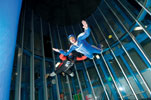
A new indoor skydive centre in Holland is flying high in the opinion of its enthusiastic users thanks to precise air control provided by 12 huge 200 kW fans at the base of the tower.

This maximum of 2,4 MW of fan power is controlled by 12 freestanding 200 kW Unidrive SP cubicle drives with an additional four 110 kW Unidrive SP drives providing ventilation to control air temperature in the tower. All drives are fitted with plug-in SM-applications modules and communicate with the touch-screen controller via Control Techniques’ high-speed network CTNet.
The Roosendaal Indoor Skydive Centre was founded by a group of skydivers who had the dream of building the biggest such centre in Europe. Initial talks with ventilation company Rucon led to talks with motor manufacturer, Kolmer who, in turn, introduced Control Techniques. The team began to develop a design that could accommodate both professional skydivers and the general public and a specification that included a soft-start of the big fans, simple speed control and maximum energy efficiency to keep running costs as economical as possible. In addition, whilst the blown air had to be returned in a loop, there had to be provision for the introduction of fresh air to keep ambient temperatures within acceptable limits.
The resulting design comprises a 23,5-metre tower of 4,27-metre diameter with two flight chambers, the lower for experienced skydivers, the upper for the general public, access in both cases being via a bridge and airlock.
A ring of 12 200 kW centrifugal fans, situated at the base of the tower and all locked together in speed by the Unidrive SP drives, blow air horizontally into the centre, where it is deflected vertically at a speed of up to 250 kmph (3,5 million cu metres/hour), by an aeronautically-shaped cone. At the top of the tower, air collectors return the air to the motor feeds, the back-pressure reducing power consumption. The tower’s temperature is monitored and, when the heat generated by the motors pushes the ambient beyond a comfortable level, four 110 kW ventilation fans situated at the top of the tower expel a proportion of the hot air to allow the intake of fresh air into the system.
“The cost-effective operation of the centre depends on the Control Techniques drives,” explains technical manager and skydive instructor Erwin Van Den Braak. “We need to keep power demand below set levels to prevent incurring peak charges. This means a gentle start-up of the motors. We are careful to optimise bookings together in blocks and if not possible we simply turn down the speed of the motors to about 10 Hz instead of turning them off and then having to start up the motors again which costs a lot and is not effective. Working in groups means that we need instant fan speed adjustment for each individual, depending on size and weight. Some skydiving centres do this using baffle plates with motors continuing to run at full speed, which is, of course very wasteful of energy.
The freestanding Unidrive SP design offers customers a simple AC-in AC-out solution, with a compact footprint, whilst retaining the technical flexibility and performance that has become the benchmark of the Unidrive SP range.
The standard IP20 cubicle includes rectifier, inverter drive and inductor and offers drive protection with either the customer’s protected supply or optional built-in input fuses can be fitted. The twelve 200 kW fan drives are all synchronised in speed to give the smoothest possible air-flow, free of turbulence and communicate directly with the HMI via CTNET, to give simple and instant speed control by the operator who sits alongside the flying chamber in a control booth.
The centre operates for around 40 hours a week, but this is steadily increasing as its performance becomes more widely recognised by the public. Professional skydiving teams and the military also endorse the centre and teams of up to 10 people have practised complex manoeuvres in the tower.
Professionals and beginners can practise in complete safety, becoming very proficient before they have to do it for real by jumping from an aircraft, taking much of the risk out of the whole training programme. Those who know, rate it as one of the three best in the world for stability and users travel long distances to participate in the indoor skydiving experience.
For more information contact Bill Tedd, Control Techniques Southern Africa, +27 (0)11 462 1740 or 083 647 1771, [email protected], www.controltechniques.com
| Tel: | +27 11 462 1740 |
| Email: | [email protected] |
| www: | www.controltechniques.com |
| Articles: | More information and articles about Nidec Control Techniques |

© Technews Publishing (Pty) Ltd | All Rights Reserved